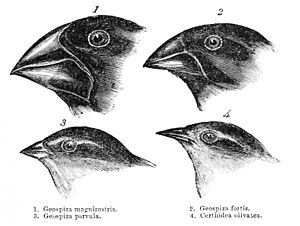What does sympatric speciation mean?
Definitions for sympatric speciation
sym·patric spe·ci·a·tion
This dictionary definitions page includes all the possible meanings, example usage and translations of the word sympatric speciation.
Wikipedia
Sympatric speciation
Sympatric speciation is the evolution of a new species from a surviving ancestral species while both continue to inhabit the same geographic region. In evolutionary biology and biogeography, sympatric and sympatry are terms referring to organisms whose ranges overlap so that they occur together at least in some places. If these organisms are closely related (e.g. sister species), such a distribution may be the result of sympatric speciation. Etymologically, sympatry is derived from the Greek roots συν ("together") and πατρίς ("homeland"). The term was coined by Edward Bagnall Poulton in 1904, who explains the derivation.Sympatric speciation is one of three traditional geographic modes of speciation. Allopatric speciation is the evolution of species caused by the geographic isolation of two or more populations of a species. In this case, divergence is facilitated by the absence of gene flow. Parapatric speciation is the evolution of geographically adjacent populations into distinct species. In this case, divergence occurs despite limited interbreeding where the two diverging groups come into contact. In sympatric speciation, there is no geographic constraint to interbreeding. These categories are special cases of a continuum from zero (sympatric) to complete (allopatric) spatial segregation of diverging groups.In multicellular eukaryotic organisms, sympatric speciation is a plausible process that is known to occur, but the frequency with which it occurs is not known. In bacteria, however, the analogous process (defined as "the origin of new bacterial species that occupy definable ecological niches") might be more common because bacteria are less constrained by the homogenizing effects of sexual reproduction and are prone to comparatively dramatic and rapid genetic change through horizontal gene transfer.
Wikidata
Sympatric speciation
Sympatric speciation is the process through which new species evolve from a single ancestral species while inhabiting the same geographic region. In evolutionary biology and biogeography, sympatric and sympatry are terms referring to organisms whose ranges overlap or are even identical, so that they occur together at least in some places. If these organisms are closely related, such a distribution may be the result of sympatric speciation. Etymologically, sympatry is derived from the Greek roots συν and πατρίς. The term was invented by Poulton in 1904, who explains the derivation. Sympatric speciation is one of three traditional geographic categories for the phenomenon of speciation. Allopatric speciation is the evolution of geographically isolated populations into distinct species. In this case, divergence is facilitated by the absence of gene flow, which tends to keep populations genetically similar. Parapatric speciation is the evolution of geographically adjacent populations into distinct species. In this case, divergence occurs despite limited interbreeding where the two diverging groups come into contact.
Numerology
Chaldean Numerology
The numerical value of sympatric speciation in Chaldean Numerology is: 2
Pythagorean Numerology
The numerical value of sympatric speciation in Pythagorean Numerology is: 1
Translations for sympatric speciation
From our Multilingual Translation Dictionary
Get even more translations for sympatric speciation »
Translation
Find a translation for the sympatric speciation definition in other languages:
Select another language:
- - Select -
- 简体中文 (Chinese - Simplified)
- 繁體中文 (Chinese - Traditional)
- Español (Spanish)
- Esperanto (Esperanto)
- 日本語 (Japanese)
- Português (Portuguese)
- Deutsch (German)
- العربية (Arabic)
- Français (French)
- Русский (Russian)
- ಕನ್ನಡ (Kannada)
- 한국어 (Korean)
- עברית (Hebrew)
- Gaeilge (Irish)
- Українська (Ukrainian)
- اردو (Urdu)
- Magyar (Hungarian)
- मानक हिन्दी (Hindi)
- Indonesia (Indonesian)
- Italiano (Italian)
- தமிழ் (Tamil)
- Türkçe (Turkish)
- తెలుగు (Telugu)
- ภาษาไทย (Thai)
- Tiếng Việt (Vietnamese)
- Čeština (Czech)
- Polski (Polish)
- Bahasa Indonesia (Indonesian)
- Românește (Romanian)
- Nederlands (Dutch)
- Ελληνικά (Greek)
- Latinum (Latin)
- Svenska (Swedish)
- Dansk (Danish)
- Suomi (Finnish)
- فارسی (Persian)
- ייִדיש (Yiddish)
- հայերեն (Armenian)
- Norsk (Norwegian)
- English (English)
Word of the Day
Would you like us to send you a FREE new word definition delivered to your inbox daily?
Citation
Use the citation below to add this definition to your bibliography:
Style:MLAChicagoAPA
"sympatric speciation." Definitions.net. STANDS4 LLC, 2025. Web. 23 Feb. 2025. <https://www.definitions.net/definition/sympatric+speciation>.







Discuss these sympatric speciation definitions with the community:
Report Comment
We're doing our best to make sure our content is useful, accurate and safe.
If by any chance you spot an inappropriate comment while navigating through our website please use this form to let us know, and we'll take care of it shortly.
Attachment
You need to be logged in to favorite.
Log In